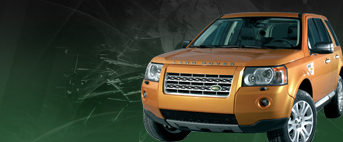In deep sand or snow you probably would need to pressure down, and hopefully you won't have to worry about damaging your rims there. You can probably go down to 20 psi or so, but I would reinflate soon after. Obviously consider vehicle weight and what tire you're running
Sorry, but I disagree. Sand and snow want big fat cushy tires to help you "float" on the surface instead of digging in. Airing down the tires increases their contact patch or footprint on the soft surface and helps prevent digging in. The sidewalls of the LR4s stock tires are so skinny that airing down the tires wouldn't give much, if any, benefit of an increased footprint, but it would increase risk of damage to the rims.
Check out the video I posted of a Discovery 4 in australia doing some tough off-roading on street tires. It is much more than what you're planning and it handled the stuff with no problems.
If you are in the sand and you get stuck you can let some air out and it will help you getting out. Sand will not ruin your tires. Also, plan on carrying a 12V inflator in the truck to air up again after letting air out.
Alex, I loved that video! Thanks so much for posting it. I wouldn't say that the LR4 handled the obstacles with "no problems". I seem to remember a winch in there somewhere

The Land Rover traction control allowed the LR4 to perform adequately in spite of having terrible wheels and tires for off-roading. I don't think you all realize how terribly hamstrung the LR4 is because of its wheels and tires.
Here's a rather long-winded armchair analysis. Take it for what it's worth.
The most capable off road vehicles have large diameter tires with small diameter wheels and lots of sidewall and some beefy lugs at the edges of the tread. They also have manually actuated locking differentials for traction control in iffy conditions. Part time 4WD trucks will need 2 locking diffs. Full time 4WD trucks need a third locker because there's an extra diff in the transfer case. The problem with locking differentials is that if they are improperly used they can cause damage to the driveline. Using them properly requires some education, just as with many aspects of off-road driving.
Land Rover is trying to give us a short cut to off-road driving without our having to educate ourselves. This is nice in a way, but ultimately they do a disservice to us and themselves, because the vehicles they produce today are less capable than they could be.
There are automatic locking diffs out there, but they are a little quirky. They make noises at odd times on the street and can be a little squirrely. It's no wonder that Land Rover didn't opt for them, because for the uninitiated and those who never intend to take their glam-mobile off road they would be a constant annoyance. Manually actuated lockers are superior but as I said they require training to ensure that the driveline isn't damaged.
So enter the ABS-based traction control system. Let it be said up front that if building the most capable off road vehicle is the goal, ABS traction control is definitely a compromise. It's benefit is that it can be made automatic. However, it does add considerable extra expense to the vehicle. And if the vehicle is acutally driven off-road then brake component wear is accelerated. The complexity of the system means that overall reliability suffers.
One specific problem with ABS traction control is that if it is used in a rigorous manner, the brake fluid will boil. That's bad.
It really sucks that we are stuck with such large diameter wheels, because it prevents us from using proper off road tires that have a nice generous sidewall. The limiting factor is the really, really huge brake rotors that limit us to enormous rims. I've asked myself why Land Rover would do this, and I can only offer a guess. If anyone tells you that the rotors have to be that big because the LR4 is so heavy don't believe them, because it's a huge load. Look at the Mercedes G-Wagen. It's as heavy or heavier than the LR4. It has brake rotors small enough to accommodate 16 inch wheels, and it stops just fine. The G-Wagen also has 3 locking diffs from the factory.
I suggest that Land Rover uses such large rotors because with the greater diameter of the rotor, the calipers don't have to work so hard to stop the vehicle. That means that the pressures and temperatures within the brake system stay lower, and the ABS system and brake fluid don't cook themselves as easily under rigorous off-road use. If this is Land Rover's rationale, I understand it, but I don't like it much. On the other hand, I could be totally off base. It could be that the LR4 has such stupidly huge rotors because those are the rotors that are used on Jaguars, and it's just cheaper to use the same thing.
In any case, those of us who really want to wheel are limited by the tire and wheel size of our LR4s.
Whew! Sorry for the rant.


 The Land Rover traction control allowed the LR4 to perform adequately in spite of having terrible wheels and tires for off-roading. I don't think you all realize how terribly hamstrung the LR4 is because of its wheels and tires.
The Land Rover traction control allowed the LR4 to perform adequately in spite of having terrible wheels and tires for off-roading. I don't think you all realize how terribly hamstrung the LR4 is because of its wheels and tires.